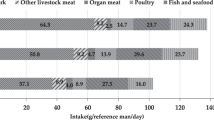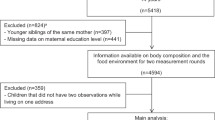Abstract
Objective: To examine trends in macronutrient intake, overweight, and obesity.
Design: Cross-sectional samples—collected nine times between 1992 and 2000—from the Russian Longitudinal Monitoring Survey provide interviewer-administered 24-h diet recalls and measured height and weight, together with detailed information regarding income and expenditures.
Setting: The Russian Federation.
Subjects: Women and men, aged 19–55 y.
Interventions: None.
Methods: A nationally representative sample of working-age Russian adults was stratified by gender and income (per cent of regional poverty level). Secular trends in mean energy and macronutrient intake, as well as prevalence of overweight and obesity in the population are described over the first 8 y of the Russian Federation.
Results: Overall, energy intake increased slightly. Fat, as a percentage of energy (E%), decreased from 39.6 to 31.6% and protein, as a per cent of energy, decreased from 14.3 to 12.5%. Overweight (determined by body mass index (BMI) ≥25 kg/m2) prevalence remained relatively stable at about 50% and obesity (BMI ≥30 kg/m2) prevalence increased from 13.3 to 16.0% of the adult population. Women consumed less energy than men and displayed higher prevalences of overweight and obesity in all time periods. There was an income effect among men in all time periods, with higher-income men consuming more calories, fat, and protein than lower-income men; this effect was not apparent in women except in the proportion of fat and protein intake.
Conclusions: The adult Russian population appears to have escaped macronutrient privation during economic reform and has experienced increasing rates of obesity.
Sponsorship: US National Institutes of Health (R01-HD30880 and R01-HD38700)
This is a preview of subscription content, access via your institution
Access options
Subscribe to this journal
Receive 12 print issues and online access
$259.00 per year
only $21.58 per issue
Buy this article
- Purchase on Springer Link
- Instant access to full article PDF
Prices may be subject to local taxes which are calculated during checkout






Similar content being viewed by others
References
Andrews M, Kantor LS, Lino M & Ripplinger D (2001): Using USDA's Thrifty Food Plan to assess food availability and affordability. Food Rev. 24, 45–53.
Baturin AK (1994): Nutrition of Russian population, 1989–1993 [Russian]. Voprosy Pitaniia 3, 4–8.
Beliaev EN (1996): Monitoring pitania i kachestvo pischevih produktov v sisteme socialno gigienicheskogo monitoringa v Rossiyskoi Ferderacii. Voprosy Pitaniia 3, 3–8.
Biloukha OO & Utermohlen V (2001): Healthy eating in Ukraine: attitudes, barriers and information sources. Public Health Nutr. 4, 207–215.
Bobak M & Marmot M (1996): East–West mortality divide and its potential explanations: proposed research agenda. BMJ 312, 421–425.
Bobak M, Pikhart H, Rose R, Hertzman C & Marmot M (2000): Socioeconomic factors, material inequalities, and perceived control in self-rated health: cross-sectional data from seven post-communist countries. Soc. Sci. Med. 51, 1343–1350.
Bray GA & Popkin BM (1998): Dietary fat does affect obesity! Am. J. Clin. Nutr. 68, 1157–1173.
Clarke S, Varshavskaya L, Alasheev S & Karelina M (2000): The myth of the urban peasant. Work, Employment, Soc. 14, 481–499.
Cockerham WC (2000): Health lifestyles in Russia. Soc. Sci. Med. 51, 1313–1324.
Cornia GA (1994): Poverty, food consumption, and nutrition during the transition to the market economy in Eastern Europe. Am. Econ. Rev. 84, 297–302.
Dennis BH, Thoma RP, Irving SH, Furberg B, Deev AD & Khaltaev NG (1988): Nutrient intake in women aged 20 to 69 years from US and USSR lipid research clinic populations. Atherosclerosis Rev. 17, 221–242.
Dennis B, Pajak A, Pardo B, Davis C, Williams O & Piotrowski W (2000): Weight gain and its correlates in Poland between 1983 and 1993. Int. J. Obes. Relat. Metab. Disord. 24, 1507–1513.
Ingram DD, Thorn MD, Stinnett SS & Deev AD (1985): USSR and US nutrient intake, plasma lipids, and lipoproteins in men ages 40–59 sampled from lipid research clinics populations. Prev. Med. 13, 264–271.
International Obesity Task Force (1998): Managing the Global Epidemic of Obesity. Geneva: World Health Organization. Report of a WHO Consultation on Obesity, 5–7 June, 1997, pp 8–9. Geneva: WHO.
Kniazhev VA, Onishchenko GG, Bol'shakov OV, Baturin AK & Tutel'ian VA (1998): Urgent issues of nutrition improvement and public health of Russian population: concept of state policy in the field of healthy nutrition of Russian population for the period up to the year 2005 [Russian]. Voprosy Pitaniia 1, 3–7.
Krauss RM, Winston M, Fletcher BJ & Grundy SM (1998): Obesity: impact on cardiovascular disease. (AHA Conference Proceedings) Circulation 98, 1472–1476.
Laatikainen T, Delong L, Pokusajeva S, Uhanov M, Vartianinen E & Puska P (2002): Changes in cardiovascular risk factors and health behaviors from 1992 to 1997 in the Republic of Karelia, Russia. Eur J Public Health 12, 37–43.
Lokshin M, Harris KM & Popkin BM (2001): Single mothers in Russia: household strategies for coping with poverty. Policy Research Working Paper 2300. Policy Research Dissemination Center: Washington, DC.
Lokshin M & Popkin BM (1999): The emerging underclass in the Russian Federation: income dynamics 1992–96. Econ. Dev. Cult. Change 47, 803–829.
Marmot M & Bobak M (2000): International comparators and poverty and health in Europe. BMJ 321, 1124–1128.
Mokdad AH, Serdula MK, Dietz WH, Bowman BA, Marks JS & Koplan JP (1999): The spread of the obesity epidemic in the United States, 1991–1998. JAMA 282, 1519–1522.
Molarius A, Seidell JC, Sans S, Tuomilehto J & Kuulasmaa K (2000): Educational level, relative body weight, and changes in their association over 10 years: an international perspective from the WHO MONICA project. Am. J. Public Health 90, 1260–1268.
Mroz TA & Popkin BM (1995): Poverty and the economic transition in the Russian Federation. Econ. Dev. Cult. Change 44, 1–31.
Pokrovskiy VI, Beliaev EN & Tutel'ian VA (1995): Prodovolstvennaja bezopastnost Rossii [Russian]. Vestnik RAMN 12, 9–13.
Pokrovskiy V, Romanenko G, Kniagev V, Gerasimenko, Onischenko G, Tutel'ian V & Pozdniakovskiy V (2002): Policy of Healthy Diet. Federal and Regional Levels (Russian), p 344. Novosibirsk: Siberian University Press.
Pomerleau J, Pudule I, Grinberga D, Kadziauskiene K, Abaravicius A, Bartkeviciute R, Vaask S, Robertson A & McKee M (2000): Patterns of body weight in the Baltic Republics. Public Health Nutr. 3, 3–10.
Pomerleau J, McKee M, Robertson A, Kadziauskiene K, Abaravicius A, Vaask S, Pudule I & Grinberga D (2001): Macronutrient and food intake in the Baltic republics. Eur. J. Clin. Nutr. 55, 200–207.
Popkin BM, Baturin A, Kohlmeier L & Zohoori N (1997a). Russia: monitoring nutritional change during the reform period. In: Implementing Dietary Guidelines for Healthy Eating. ed. V Wheelock, pp 23–46. London: Chapman & Hall.
Popkin BM, Zohoori N, Kohlmeier L, Baturin AK, Martinchik AN & Deev A (1997b): Nutritional Risk Factors in the Former Soviet Union. In Premature Death in the New Independent States, eds. J Bobadilla, C Costello & F Mitchell, pp 314–334 Washington, DC: National Academy Press.
Russia Longitudinal Monitoring Survey [On line]. Available at http://www.cpc.unc.edu/projects/rlms/rlms_home.html [Accessed 24 August 2001.]
Shkolnikov V, Mesle F & Vallin J (1997): Recent trends in life expectancy and causes of death in Russia, 1970–1993. In Premature Death in the New Independent States, eds. J Bobadilla, C Costello & F Mitchell, pp 34–65. Washington, DC: National Academy Press.
Shkolnikov V, McKee M & Leon DA (2001): Changes in life expectancy in Russia in the mid-1990s. Lancet 357, 917–921.
StataCorp. (2001): Stata Statistical Software: Release 7.0. College Station, TX: Stata Corporation.
Stillman S (2001): The response of consumption in Russian households to economic shocks. IZA Discussion Paper 411 (December).
Swafford MS & Kosolapov MS (2002): Sample design, response rates, and weights in the Russia Longitudinal Monitoring Survey, Rounds 5 to 10: an abbreviated description. May 2002.
Tulchinsky TH & Varavikova EA (1996): Addressing the epidemiologic transition in the former soviet union: strategies for health system and public health reform in Russia. Am. J. Public Health 86, 313–320.
Visscher TLS & Seidell JC (2001): The public health impact of obesity. Ann. Rev. Public Health 22, 355–375.
Visscher TLS, Kromhout D & Seidell JC (2002): Long-term and recent time trends in the prevalence of obesity among Dutch men and women. Int. J. Obes. Relat. Metab. Disord. 26, 1218–1224.
Walberg P, McKee M, Shkolnikov V, Chenet L & Leon DA (1998): Economic change, crime, and mortality crisis in Russia: regional analysis. BMJ 317, 312–318.
World Health Organization (1998): Food, Nutrition and Health Policy in the Russian Federation. World Health Organization. (document EUR/RUS/LVNG 02 01 09) [On-line]. Available at http://www.who.dk/document/e58453.pdf. (Accessed 23 September 2002.)
World Health Organization (2002): The European Health Report 2002. World Health Organization [On-line]. Available at http://www.euro.who.int/eprise/main/who/progs/ehr/home. (Accessed 24 September 2002.)
Zohoori N, Mroz TA, Popkin B, Glinskaya B, Lokshin M, Mancini D, Kozyreva P, Kosolapov M & Swafford M (1998): Monitoring the economic transition in the Russian Federation and its implications for the demographic crisis—the Russian Longitudinal Monitoring Survey. World Dev. 26, 1977–1993.
Acknowledgements
We thank Andrew Yim, Anna Safronova, Rosalind King, and Sonya Jones for their comments, Tom Swasey for help with the graphics, Karin Gleiter and Laura Henderson for help with the database work, and Frances Dancy for her help with the manuscript. Source of Support: US National Institutes of Health (NIH) (R01-HD30880 and R01-HD38700).
Author information
Authors and Affiliations
Contributions
Guarantor: B Popkin.
Contributors: LJ led the project, discussed core ideas, analysed data, drafted and amended the paper. AB and BMP participated in the design and collection of RLMS data, discussed core ideas, and commented on drafts.
Corresponding author
Rights and permissions
About this article
Cite this article
Jahns, L., Baturin, A. & Popkin, B. Obesity, diet, and poverty: trends in the Russian transition to market economy. Eur J Clin Nutr 57, 1295–1302 (2003). https://doi.org/10.1038/sj.ejcn.1601691
Received:
Revised:
Accepted:
Published:
Issue Date:
DOI: https://doi.org/10.1038/sj.ejcn.1601691
Keywords
This article is cited by
-
Estimated and forecasted trends in domain specific time-use and energy expenditure among adults in Russia
International Journal of Behavioral Nutrition and Physical Activity (2014)
-
Human gut microbiota community structures in urban and rural populations in Russia
Nature Communications (2013)
-
The Role of Adolescent Behaviors in the Female–Male Disparity in Obesity Incidence in US Black and White Young Adults
Obesity (2010)
-
Dietary habits in three Central and Eastern European countries: the HAPIEE study
BMC Public Health (2009)
-
Are Child Eating Patterns Being Transformed Globally?
Obesity Research (2005)



